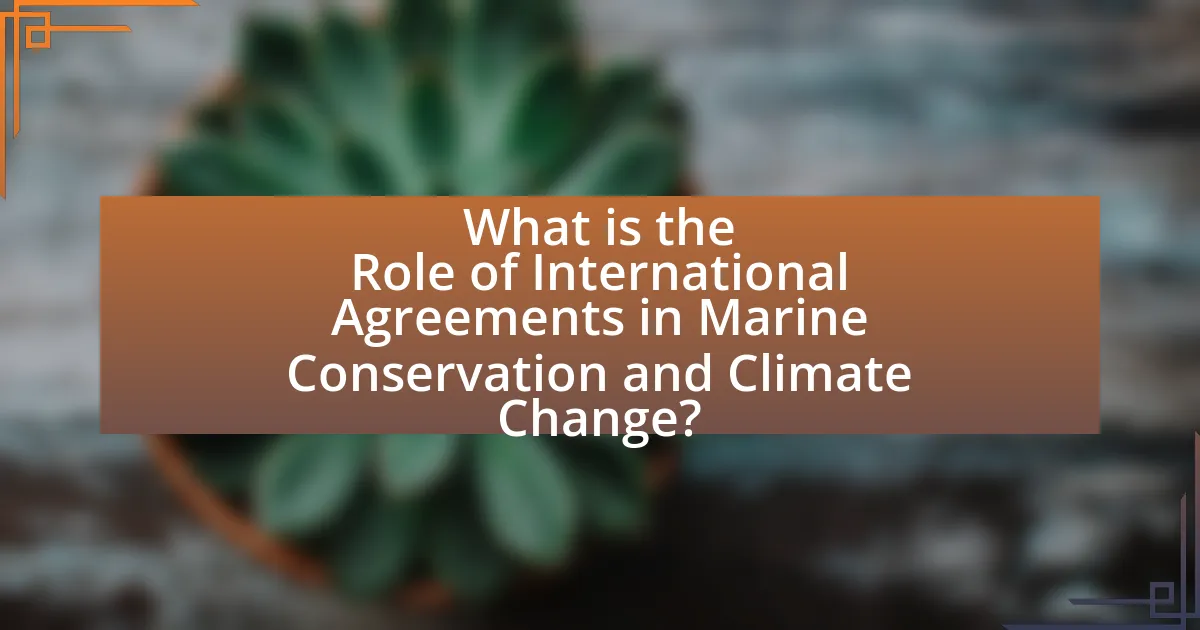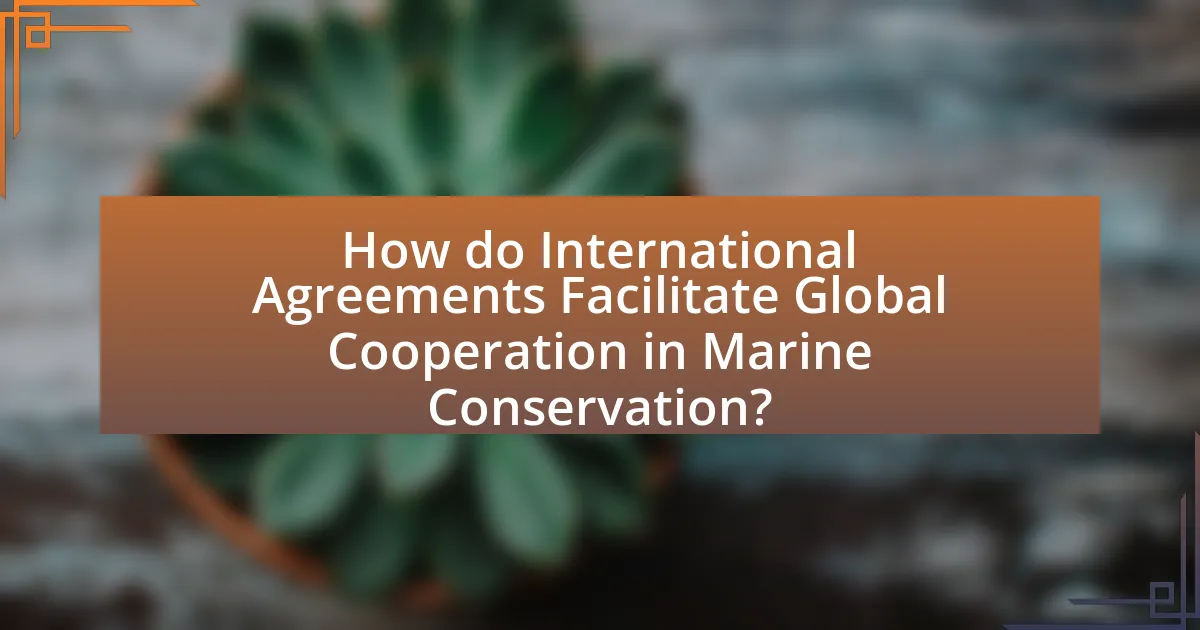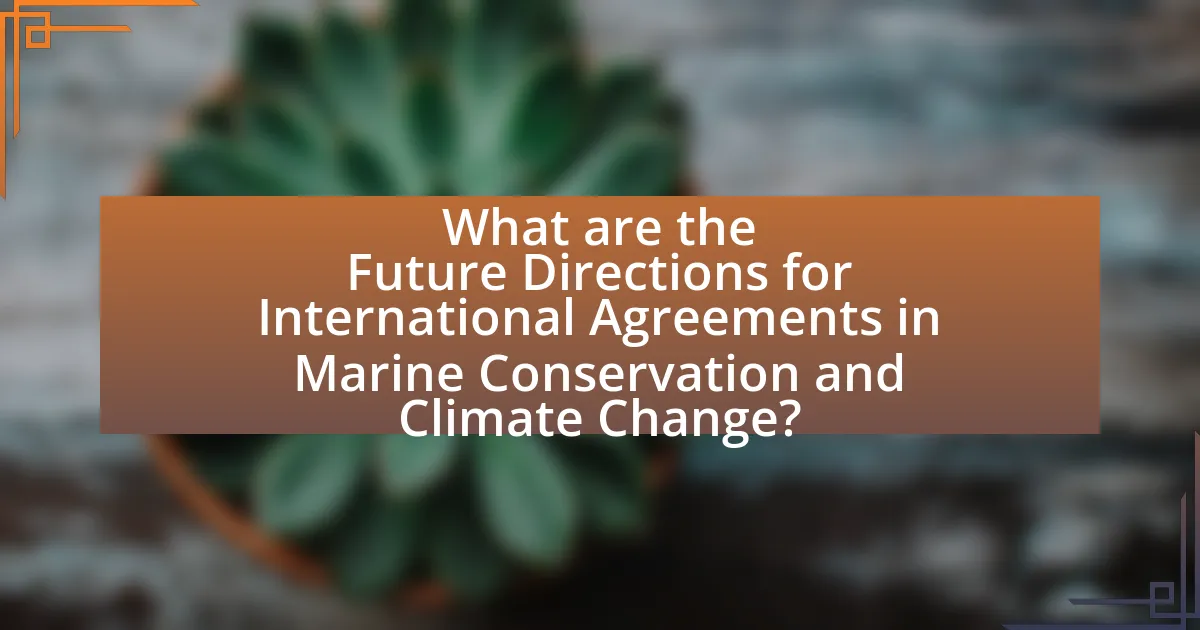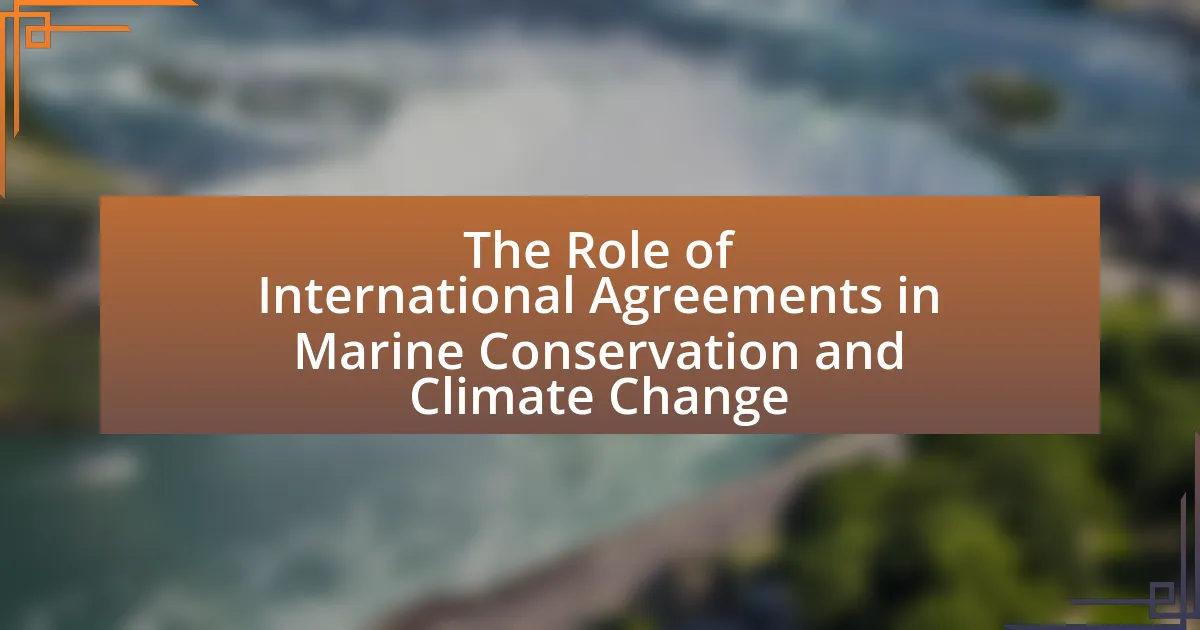International agreements are essential for marine conservation and addressing climate change, as they provide frameworks for cooperation among nations to protect marine ecosystems and mitigate climate impacts. Key agreements such as the Paris Agreement, the Convention on Biological Diversity, and the United Nations Convention on the Law of the Sea establish binding commitments for reducing greenhouse gas emissions and preserving marine biodiversity. These agreements facilitate international collaboration, promote sustainable management of ocean resources, and address challenges like overfishing and habitat destruction. The article explores the role of these agreements in influencing national policies, the impact of climate change on marine environments, and the challenges faced in enforcement and compliance, while also highlighting future directions for enhancing marine conservation efforts.

What is the Role of International Agreements in Marine Conservation and Climate Change?
International agreements play a crucial role in marine conservation and climate change by establishing frameworks for cooperation among nations to protect marine ecosystems and mitigate climate impacts. These agreements, such as the Paris Agreement and the Convention on Biological Diversity, set binding targets and guidelines for reducing greenhouse gas emissions and preserving marine biodiversity. For instance, the Paris Agreement aims to limit global warming to well below 2 degrees Celsius, which directly influences marine environments by addressing ocean acidification and temperature rise. Additionally, the United Nations Sustainable Development Goal 14 emphasizes the need to conserve and sustainably use the oceans, seas, and marine resources, highlighting the importance of international collaboration in achieving these objectives.
How do international agreements contribute to marine conservation efforts?
International agreements contribute to marine conservation efforts by establishing legally binding commitments among nations to protect marine biodiversity and manage ocean resources sustainably. For instance, the United Nations Convention on the Law of the Sea (UNCLOS) provides a framework for the conservation and sustainable use of marine resources, including the protection of marine ecosystems and the regulation of fishing practices. Additionally, agreements like the Convention on Biological Diversity (CBD) promote the conservation of marine and coastal biodiversity through national strategies and action plans. These agreements facilitate international cooperation, enabling countries to share resources, knowledge, and best practices, which enhances the effectiveness of marine conservation initiatives globally.
What are the key international agreements focused on marine conservation?
The key international agreements focused on marine conservation include the United Nations Convention on the Law of the Sea (UNCLOS), the Convention on Biological Diversity (CBD), and the Paris Agreement. UNCLOS, adopted in 1982, establishes guidelines for the use of the world’s oceans and marine resources, promoting sustainable management and conservation. The CBD, established in 1992, aims to conserve biological diversity, including marine ecosystems, and requires parties to develop national strategies for conservation. The Paris Agreement, adopted in 2015, addresses climate change impacts on marine environments by committing countries to limit global warming, which indirectly supports marine conservation efforts. These agreements collectively provide a framework for protecting marine biodiversity and ecosystems globally.
How do these agreements impact marine biodiversity?
International agreements significantly impact marine biodiversity by establishing frameworks for the protection and sustainable management of marine ecosystems. These agreements, such as the Convention on Biological Diversity and the Paris Agreement, promote conservation efforts that help mitigate threats like overfishing, habitat destruction, and climate change. For instance, the Convention on Biological Diversity aims to protect marine areas, which can enhance species diversity and ecosystem resilience. Additionally, the implementation of marine protected areas (MPAs) under these agreements has been shown to increase fish populations and biodiversity, as evidenced by studies indicating that MPAs can lead to a 20-50% increase in species richness. Thus, international agreements play a crucial role in safeguarding marine biodiversity through coordinated conservation strategies and regulatory measures.
Why is climate change a critical issue for marine environments?
Climate change is a critical issue for marine environments because it leads to ocean warming, acidification, and sea level rise, which disrupt marine ecosystems. Ocean temperatures have increased by approximately 1.1 degrees Celsius since the late 19th century, causing coral bleaching and altering species distributions. Additionally, the absorption of excess atmospheric CO2 has resulted in ocean acidification, decreasing the availability of carbonate ions essential for shell-forming organisms. Sea level rise, projected to reach up to 1 meter by 2100, threatens coastal habitats and increases the risk of flooding. These changes collectively jeopardize biodiversity, fisheries, and the livelihoods of communities dependent on marine resources.
What are the effects of climate change on marine ecosystems?
Climate change significantly impacts marine ecosystems by altering ocean temperatures, acidifying waters, and disrupting species distributions. Rising ocean temperatures lead to coral bleaching, which affects biodiversity and the health of coral reefs, vital habitats for numerous marine species. Ocean acidification, caused by increased carbon dioxide absorption, negatively affects shellfish and other calcifying organisms, threatening their survival and the marine food web. Additionally, shifting species distributions due to changing temperatures can result in altered predator-prey relationships and ecosystem dynamics, further destabilizing marine environments. These effects underscore the urgent need for international agreements to address climate change and protect marine biodiversity.
How do international agreements address climate change in marine contexts?
International agreements address climate change in marine contexts primarily through frameworks that promote sustainable management of marine resources and protection of marine ecosystems. For instance, the Paris Agreement, adopted in 2015, encourages countries to limit global warming, which directly impacts ocean temperatures and acidification, thereby affecting marine biodiversity. Additionally, the United Nations Convention on the Law of the Sea (UNCLOS) establishes guidelines for the conservation and sustainable use of oceans, emphasizing the need for cooperation among nations to address climate-related impacts on marine environments. These agreements often include specific targets and commitments, such as reducing greenhouse gas emissions and enhancing marine protected areas, which are essential for mitigating the effects of climate change on marine life.
What challenges do international agreements face in marine conservation?
International agreements in marine conservation face significant challenges, including differing national interests, enforcement issues, and inadequate funding. Countries often prioritize their economic activities, such as fishing and tourism, over conservation efforts, leading to conflicts in policy implementation. For instance, the United Nations Convention on the Law of the Sea (UNCLOS) has been criticized for its limited enforcement mechanisms, making it difficult to hold nations accountable for overfishing or pollution. Additionally, financial constraints hinder the ability of many countries to participate fully in international agreements, as seen in the Global Environment Facility’s reports indicating that funding for marine conservation is often insufficient to meet the needs outlined in agreements. These factors collectively undermine the effectiveness of international efforts to protect marine ecosystems.
How do differing national interests affect the effectiveness of these agreements?
Differing national interests significantly undermine the effectiveness of international agreements in marine conservation and climate change. When countries prioritize their own economic, political, or social goals over collective environmental objectives, it leads to inconsistent commitments and enforcement of agreements. For instance, the Paris Agreement on climate change relies on voluntary commitments from nations, which can vary widely based on national interests, resulting in insufficient global action to meet climate targets. A study by the World Resources Institute highlights that countries with strong fossil fuel industries may resist stringent regulations, thereby weakening the overall impact of climate agreements. This divergence in priorities creates challenges in achieving consensus and implementing effective measures for marine conservation and climate change mitigation.
What role does enforcement play in the success of international agreements?
Enforcement is crucial for the success of international agreements as it ensures compliance and accountability among participating nations. Without effective enforcement mechanisms, countries may fail to adhere to their commitments, undermining the objectives of agreements aimed at marine conservation and climate change. For instance, the Paris Agreement relies on national commitments to reduce greenhouse gas emissions, but its effectiveness is contingent upon countries implementing and enforcing their pledges. Studies have shown that agreements with robust enforcement provisions, such as penalties for non-compliance, tend to achieve better outcomes, as seen in the Convention on International Trade in Endangered Species (CITES), which has successfully regulated trade in threatened species through enforcement measures.

How do International Agreements Facilitate Global Cooperation in Marine Conservation?
International agreements facilitate global cooperation in marine conservation by establishing legally binding commitments among nations to protect marine biodiversity and manage shared resources sustainably. These agreements, such as the Convention on Biological Diversity and the United Nations Convention on the Law of the Sea, provide frameworks for collaboration, enabling countries to coordinate efforts in monitoring, research, and enforcement of conservation measures. For instance, the Global Ocean Treaty aims to create marine protected areas in international waters, promoting collective action to address threats like overfishing and habitat destruction. Such frameworks enhance accountability and foster partnerships, ensuring that countries work together to achieve common conservation goals.
What mechanisms are in place for countries to collaborate on marine issues?
Countries collaborate on marine issues through various international agreements and organizations, such as the United Nations Convention on the Law of the Sea (UNCLOS), which establishes guidelines for the use of the world’s oceans and marine resources. Additionally, regional fisheries management organizations (RFMOs) facilitate cooperation among countries to manage fish stocks and ensure sustainable fishing practices. The Convention on Biological Diversity (CBD) also promotes the conservation of marine biodiversity through collaborative efforts among nations. These mechanisms are supported by scientific research and data-sharing initiatives, which enhance collective understanding and management of marine ecosystems.
How do treaties and conventions promote shared responsibilities?
Treaties and conventions promote shared responsibilities by establishing legally binding commitments among nations to address common challenges, such as marine conservation and climate change. These agreements create frameworks for cooperation, enabling countries to coordinate their efforts, share resources, and implement joint strategies. For instance, the Paris Agreement requires signatory nations to set and achieve their own climate targets while collectively working towards limiting global warming, thereby fostering accountability and mutual support. This collaborative approach ensures that all parties recognize their roles and obligations, leading to more effective and equitable solutions to global issues.
What role do NGOs play in supporting international agreements?
NGOs play a crucial role in supporting international agreements by advocating for policy changes, raising public awareness, and facilitating stakeholder engagement. They often serve as intermediaries between governments and local communities, ensuring that the voices of affected populations are heard in negotiations. For instance, organizations like Greenpeace and the World Wildlife Fund have actively participated in international climate talks, influencing agreements such as the Paris Agreement by providing scientific research and mobilizing public support. Their efforts contribute to the implementation and monitoring of these agreements, ensuring accountability and promoting sustainable practices in marine conservation and climate change initiatives.
How do international agreements influence national policies on marine conservation?
International agreements significantly influence national policies on marine conservation by establishing legally binding commitments and frameworks that countries must adhere to. For instance, the United Nations Convention on the Law of the Sea (UNCLOS) sets guidelines for the sustainable use of ocean resources, compelling nations to develop policies that align with its principles. Additionally, agreements like the Convention on Biological Diversity (CBD) encourage countries to create national strategies for the conservation of marine biodiversity, often leading to the establishment of marine protected areas. These international frameworks provide a basis for collaboration, funding, and scientific research, which further shapes national legislation and enforcement mechanisms aimed at protecting marine ecosystems.
What are examples of national policies shaped by international agreements?
Examples of national policies shaped by international agreements include the United States’ implementation of the Clean Air Act, which aligns with commitments made under the Paris Agreement to reduce greenhouse gas emissions. Additionally, the European Union’s Common Fisheries Policy is influenced by international agreements such as the United Nations Convention on the Law of the Sea, which aims to ensure sustainable fishing practices. These policies demonstrate how nations adapt their regulations to meet international standards and obligations, thereby promoting global environmental goals.
How do countries report progress on their commitments?
Countries report progress on their commitments through formal submissions to international bodies, such as the United Nations Framework Convention on Climate Change (UNFCCC) and the Convention on Biological Diversity (CBD). These reports typically include data on emissions reductions, conservation efforts, and implementation of policies aligned with international agreements. For instance, under the Paris Agreement, countries submit Nationally Determined Contributions (NDCs) every five years, detailing their climate action plans and progress. Additionally, many countries participate in peer review processes and public reporting mechanisms to enhance transparency and accountability, ensuring that commitments are tracked and assessed effectively.

What are the Future Directions for International Agreements in Marine Conservation and Climate Change?
Future directions for international agreements in marine conservation and climate change include enhancing cooperation among nations, establishing legally binding targets for marine biodiversity protection, and integrating climate adaptation strategies into marine policies. The United Nations Convention on the Law of the Sea (UNCLOS) and the Paris Agreement serve as frameworks for these efforts, emphasizing the need for collaborative approaches to address transboundary marine issues. Recent initiatives, such as the Global Biodiversity Framework adopted at the COP15, aim to set specific targets for protecting marine ecosystems, highlighting the urgency of addressing climate impacts on oceans. These agreements are increasingly focusing on sustainable fisheries management, marine protected areas, and the reduction of ocean pollution, which are critical for maintaining marine biodiversity and resilience against climate change.
How can international agreements evolve to better address emerging marine challenges?
International agreements can evolve to better address emerging marine challenges by incorporating adaptive management strategies that respond to new scientific data and changing environmental conditions. For instance, the United Nations Convention on the Law of the Sea (UNCLOS) can be updated to include provisions for real-time monitoring of marine ecosystems and the establishment of dynamic marine protected areas that can shift based on ecological needs. Additionally, integrating stakeholder engagement, including local communities and indigenous knowledge, can enhance the effectiveness of these agreements. Evidence from the Convention on Biological Diversity shows that participatory approaches lead to more sustainable outcomes in marine conservation efforts.
What innovations in policy could enhance marine conservation efforts?
Innovations in policy that could enhance marine conservation efforts include the establishment of marine protected areas (MPAs) through international agreements, which can effectively safeguard biodiversity. Research indicates that MPAs can lead to a 20-30% increase in fish populations and biodiversity when properly managed. Additionally, implementing ecosystem-based management policies that consider the interconnectedness of marine species and habitats can improve resilience against climate change impacts. The Paris Agreement emphasizes the need for countries to collaborate on climate action, which can also support marine conservation by reducing ocean acidification and warming. These policy innovations are crucial for creating a sustainable framework for marine ecosystems.
How can technology improve compliance and monitoring of agreements?
Technology can improve compliance and monitoring of agreements by enabling real-time data collection and analysis, which enhances transparency and accountability. For instance, satellite monitoring systems can track illegal fishing activities in marine protected areas, providing concrete evidence of violations. Additionally, blockchain technology can create immutable records of transactions and compliance, ensuring that all parties adhere to the terms of agreements. According to a study by the World Wildlife Fund, the use of technology in monitoring has led to a 30% reduction in illegal fishing in certain regions, demonstrating its effectiveness in enforcing compliance.
What best practices can be adopted for effective marine conservation through international agreements?
Effective marine conservation through international agreements can be achieved by adopting best practices such as establishing legally binding commitments, promoting collaborative governance, and integrating scientific research into policy-making. Legally binding commitments ensure that countries adhere to specific conservation targets, as seen in the Convention on Biological Diversity, which aims to protect marine biodiversity through measurable goals. Collaborative governance involves engaging multiple stakeholders, including local communities and indigenous groups, to ensure that conservation efforts are inclusive and culturally sensitive, exemplified by the Pacific Islands Forum’s regional approach to fisheries management. Integrating scientific research into policy-making allows for evidence-based decisions, as demonstrated by the use of the best available science in the management of marine protected areas under the United Nations Convention on the Law of the Sea. These practices collectively enhance the effectiveness of international agreements in marine conservation.
How can stakeholder engagement be improved in the agreement process?
Stakeholder engagement can be improved in the agreement process by implementing structured communication strategies that facilitate transparency and inclusivity. Effective engagement involves regular consultations with stakeholders, ensuring their input is considered in decision-making, and utilizing technology for broader outreach. For instance, the United Nations Framework Convention on Climate Change (UNFCCC) emphasizes stakeholder participation through mechanisms like the Local Communities and Indigenous Peoples Platform, which has successfully integrated diverse perspectives into climate agreements. This approach not only enhances trust but also leads to more comprehensive and effective agreements in marine conservation and climate change initiatives.
What lessons can be learned from successful international agreements in other fields?
Successful international agreements in fields such as trade, health, and environmental protection demonstrate the importance of clear objectives, stakeholder engagement, and enforceable commitments. For instance, the Paris Agreement on climate change emphasizes the necessity of setting measurable targets and fostering collaboration among nations to address global challenges. Additionally, the World Health Organization’s Framework Convention on Tobacco Control illustrates how binding agreements can effectively reduce health risks through coordinated efforts and shared resources. These examples highlight that successful international agreements require transparency, adaptability, and a strong framework for accountability to achieve desired outcomes.
